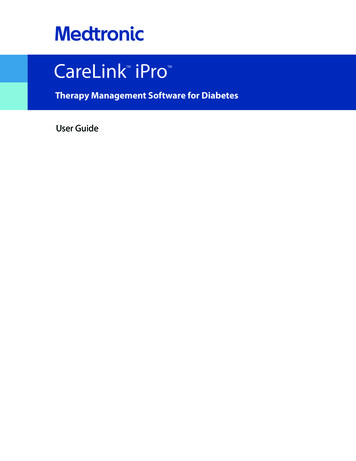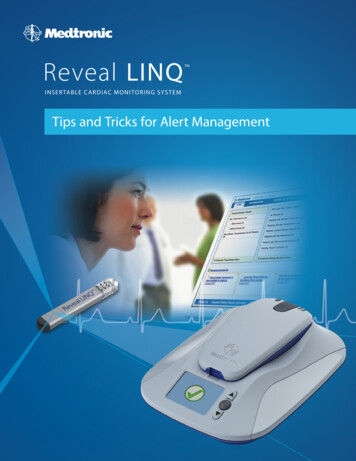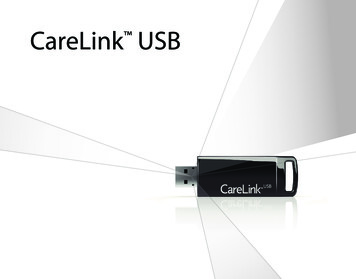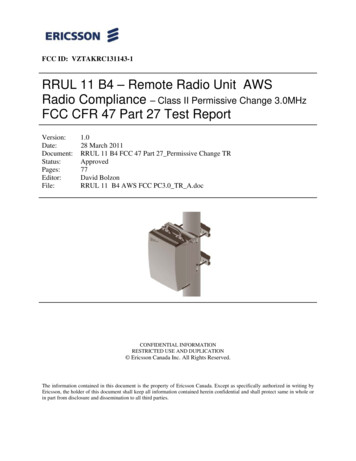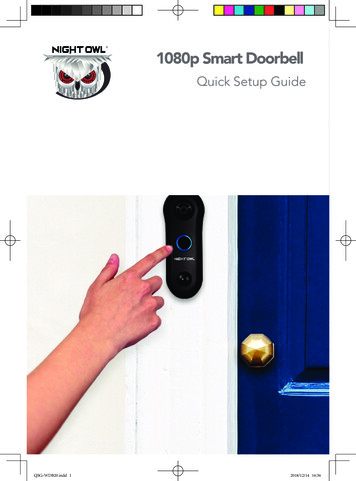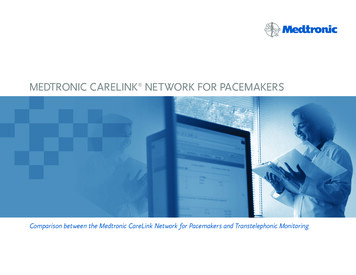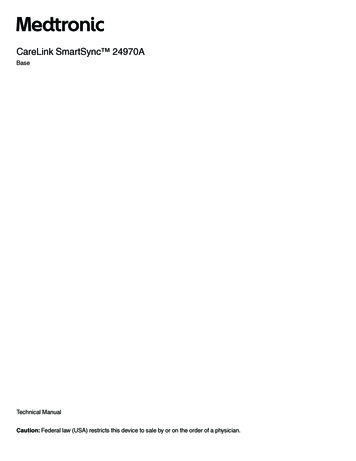
Transcription
CareLink SmartSync 24970ABaseTechnical ManualCaution: Federal law (USA) restricts this device to sale by or on the order of a physician.
The following list includes trademarks or registered trademarks of Medtronic in the United States and possibly in other countries. All other trademarks are the propertyof their respective owners.CareLink, CareLink SmartSync, Conexus, Medtronic, Medtronic CareLink
Contents1Introduction to the 24970A Base . . . . . . . . . . . . . . . . . . . . . . . . . . . . . . . . . . . . . . . . . . . . . . . . . . . . . . . . . . . . . . . . . . . . . . . . . . 41.1Explanation of packaging and product symbols . . . . . . . . . . . . . . . . . . . . . . . . . . . . . . . . . . . . . . . . . . . . . . . . . . . . . . . . . . 41.2Description . . . . . . . . . . . . . . . . . . . . . . . . . . . . . . . . . . . . . . . . . . . . . . . . . . . . . . . . . . . . . . . . . . . . . . . . . . . . . . . . . . . . . . . . . 61.3Intended use . . . . . . . . . . . . . . . . . . . . . . . . . . . . . . . . . . . . . . . . . . . . . . . . . . . . . . . . . . . . . . . . . . . . . . . . . . . . . . . . . . . . . . . 71.4Contraindications . . . . . . . . . . . . . . . . . . . . . . . . . . . . . . . . . . . . . . . . . . . . . . . . . . . . . . . . . . . . . . . . . . . . . . . . . . . . . . . . . . . 71.5Warnings . . . . . . . . . . . . . . . . . . . . . . . . . . . . . . . . . . . . . . . . . . . . . . . . . . . . . . . . . . . . . . . . . . . . . . . . . . . . . . . . . . . . . . . . . . 71.6Precautions . . . . . . . . . . . . . . . . . . . . . . . . . . . . . . . . . . . . . . . . . . . . . . . . . . . . . . . . . . . . . . . . . . . . . . . . . . . . . . . . . . . . . . . . 81.724970A base functions . . . . . . . . . . . . . . . . . . . . . . . . . . . . . . . . . . . . . . . . . . . . . . . . . . . . . . . . . . . . . . . . . . . . . . . . . . . . . 101.8Regulatory compliance . . . . . . . . . . . . . . . . . . . . . . . . . . . . . . . . . . . . . . . . . . . . . . . . . . . . . . . . . . . . . . . . . . . . . . . . . . . . . 101.9IT network, mobile device, and data information . . . . . . . . . . . . . . . . . . . . . . . . . . . . . . . . . . . . . . . . . . . . . . . . . . . . . . . . 102Setup and configuration . . . . . . . . . . . . . . . . . . . . . . . . . . . . . . . . . . . . . . . . . . . . . . . . . . . . . . . . . . . . . . . . . . . . . . . . . . . . . . . . .2.1Contents of package . . . . . . . . . . . . . . . . . . . . . . . . . . . . . . . . . . . . . . . . . . . . . . . . . . . . . . . . . . . . . . . . . . . . . . . . . . . . . . . .2.2System components . . . . . . . . . . . . . . . . . . . . . . . . . . . . . . . . . . . . . . . . . . . . . . . . . . . . . . . . . . . . . . . . . . . . . . . . . . . . . . . .2.3Compatible accessories . . . . . . . . . . . . . . . . . . . . . . . . . . . . . . . . . . . . . . . . . . . . . . . . . . . . . . . . . . . . . . . . . . . . . . . . . . . . .2.4Setup . . . . . . . . . . . . . . . . . . . . . . . . . . . . . . . . . . . . . . . . . . . . . . . . . . . . . . . . . . . . . . . . . . . . . . . . . . . . . . . . . . . . . . . . . . . .2.5Connecting the base to the app . . . . . . . . . . . . . . . . . . . . . . . . . . . . . . . . . . . . . . . . . . . . . . . . . . . . . . . . . . . . . . . . . . . . . .2.6Charging the patient connector battery . . . . . . . . . . . . . . . . . . . . . . . . . . . . . . . . . . . . . . . . . . . . . . . . . . . . . . . . . . . . . . . .2.7Troubleshooting potential interference . . . . . . . . . . . . . . . . . . . . . . . . . . . . . . . . . . . . . . . . . . . . . . . . . . . . . . . . . . . . . . . . .12121215161922233Conducting an Analyzer session . . . . . . . . . . . . . . . . . . . . . . . . . . . . . . . . . . . . . . . . . . . . . . . . . . . . . . . . . . . . . . . . . . . . . . . . .3.1Conducting an Analyzer session . . . . . . . . . . . . . . . . . . . . . . . . . . . . . . . . . . . . . . . . . . . . . . . . . . . . . . . . . . . . . . . . . . . . .3.2Delivering emergency VVI pacing . . . . . . . . . . . . . . . . . . . . . . . . . . . . . . . . . . . . . . . . . . . . . . . . . . . . . . . . . . . . . . . . . . . . .3.3Troubleshooting . . . . . . . . . . . . . . . . . . . . . . . . . . . . . . . . . . . . . . . . . . . . . . . . . . . . . . . . . . . . . . . . . . . . . . . . . . . . . . . . . . . .242425264Maintaining the 24970A base . . . . . . . . . . . . . . . . . . . . . . . . . . . . . . . . . . . . . . . . . . . . . . . . . . . . . . . . . . . . . . . . . . . . . . . . . . . . 274.1Cleaning the 24970A base . . . . . . . . . . . . . . . . . . . . . . . . . . . . . . . . . . . . . . . . . . . . . . . . . . . . . . . . . . . . . . . . . . . . . . . . . . 274.2Specifications . . . . . . . . . . . . . . . . . . . . . . . . . . . . . . . . . . . . . . . . . . . . . . . . . . . . . . . . . . . . . . . . . . . . . . . . . . . . . . . . . . . . . 305Electromagnetic compatibility declaration . . . . . . . . . . . . . . . . . . . . . . . . . . . . . . . . . . . . . . . . . . . . . . . . . . . . . . . . . . . . . . . . 313
1 Introduction to the 24970A Base1.1 Explanation of packaging and product symbolsRefer to the package label and product to see which symbols apply to this product.Consult instructions for use at www.medtronic.com/manuals.Conformité Européenne (European Conformity). This symbol means that the device fully complieswith applicable European Union Acts.Ingress protectionUse only with specified power supplyClass II ME equipment equipmentType BF applied partType CF applied partHumidity limitationNon-ionizing electromagnetic radiationDo not dispose of this product in the unsorted municipal waste stream. Dispose of this productaccording to local regulations. See http://recycling.Medtronic.com for instructions on proper disposal of this product.Direct currentManufacturerDate of manufactureAuthorized representative in the European communityFor US audiences onlyCaution: Federal law (USA) restricts this device to sale by or on the order of a physician4
Re-order numberSerial numberPackage contentsProduct documentationAccessoriesMagnetic Resonance (MR) UnsafeBluetooth connectionWireless communication enabledTelemetry enabledCaution: Strong magnetFollow instructions for use (blue)Low batteryKeep dryACMA (Australian Communications and Media Authority) and the New Zealand Ministry of Economic Development Radio Spectrum Management compliance mark for Australia and New ZealandSystem meets the applicable Canadian and U.S. IEC safety standardsTechnical Conformity (Ministry of Internal Affairs and Communications) mark for JapanOperating temperature5
Transit temperatureStorage temperatureSecurity key24970A Device manager24967 Patient connector249701 Power supply (for the 24970A base)249705 Power cord (for the 24970A base)249651 Power supply (for the 24967 patient connector)249672 Tether Kit249702 USB Cable249671 Weight Kit1.2 DescriptionThe CareLink SmartSync Device Manager system (referred to from now on as the device manager system) is comprised of the Model24970A Base, Model 24967 Patient Connector (also referred to as a telemetry head), and CareLink SmartSync Device Manager appinstalled and running on your mobile device. The CareLink SmartSync Device Manager Base (referred to from now on as the base)pairs with the Medtronic CareLink SmartSync Device Manager app on your mobile device to analyze the cardiac lead system for animplantable Medtronic device.The base includes these features: Analyzer hardware and patient cable connections to support electrical assessment of cardiac leads during implant. ECG cable connections to collect live cardiac waveform data that can be viewed, measured, and recorded using the app runningon your mobile device. Bluetooth wireless technology to communicate with the app running on your mobile device.1 A cradle to charge the Medtronic 24967 Patient Connector (referred to from now on as the patient connector). Optional USB connectivity to charge the patient connector.1The Bluetooth word mark and logos are registered trademarks owned by the Bluetooth SIG, Inc. and any such use of those marks by Medtronicis under license. 6
1.3 Intended useThe base is intended to be used as part of the CareLink SmartSync device manager system. Clinicians use the base to analyze theelectrical performance of cardiac leads during device implant or invasive troubleshooting. Clinicians use the base’s ECG connectionsalong with the app display to view, measure, and record live cardiac waveforms.The base is intended to be used by healthcare professionals only in operating environments under direct medical supervision.1.4 ContraindicationsThe base is not intended for use as an external pulse generator (EPG) outside of the implant procedure. In addition, the patient’s ageand medical condition may dictate the lead analyses appropriate for the patient.1.5 WarningsThese warnings apply in general to using the device manager system. For more information related to specific implantable devicemodels, see the reference guides for the implantable device and the software.Battery replacement – The batteries that power the integrated Analyzer hardware in the base must be replaced every 2 years orwhen they are depleted. Replace the batteries every 2 years or when the app indicates that the battery charge is low. Use of a failedbattery may reduce operating time and may cause user or patient injury.Do not replace the battery while an Analyzer session is in progress or the base is connected to a patient. The battery connects tocircuitry which connects directly to the patient and could provide a low-resistance path to the myocardium for electrostatic discharge(ESD) or leakage currents.Changing polarity settings – Confirm the polarity capabilities of the cardiac lead system before changing polarity settings.Changing polarity settings could result in loss of pacing if the cardiac lead system is not set up to facilitate pacing in the polarityselected.Cable connections – Connect all surgical cables, patient cables, and adaptors to the base before connecting the leads to the surgicalor patient cable. Ensure proper atrial or ventricular lead connections are made to the surgical or patient cables. For more informationon connecting surgical or patient cables to leads, refer to the instructions for use for the selected surgical or patient cable.Connection of external devices – Additional equipment connected to medical electrical equipment must comply with the respectiveIEC or ISO standards (for example, IEC 60950 for data processing equipment). All configurations must comply with the requirementsfor medical electrical systems (see IEC 60601-1-1 or clause 16 of the 3rd edition of IEC 60601-1, respectively). Anyone connectingadditional equipment to medical electrical equipment configures a medical system and is therefore responsible that the systemcomplies with the requirements for medical electrical systems. Local laws take priority over the above mentioned requirements. If indoubt, consult your local Medtronic representative or the technical service department.Damage due to impact – Do not use the base if it has sustained impact damage. Internal components may be damaged or exposed.Use of damaged equipment may impact user or patient safety.DDD pacing mode – Do not operate the Analyzer hardware in the base in the DDD pacing mode when only the ventricular pacinglead is connected. Interference detected at the unconnected atrial input of the Analyzer hardware can result in false sensing and candrive the ventricular pacing rate to the Upper Rate setting.Defibrillation/cardioversion – Whenever possible, for the safety of the patient, disconnect the base from the lead cardiac systembefore defibrillating or cardioverting.The Analyzer hardware in the base may be damaged by defibrillatory discharges when it is connected to an indwelling cardiac leadsystem. The Analyzer hardware recovers normal operation within two seconds in the ventricle and within six seconds in the atrium for thedefibrillation test pulse defined in IEC 60601-2-31. The Analyzer hardware should be tested after being exposed to such charges.Diagnostic ECG – Do not use the ECG display for diagnosis. Use a separate ECG device if diagnostic ECG capabilities are required.Electric shock risk – Do not simultaneously touch the patient and any metal parts of the base (such as the USB port, powerconnector, or patient connector charging contacts) as voltage may be present. Application of voltage to the patient may impact useror patient safety.Electrostatic discharge (ESD) – Discharge any static electricity from your body before touching the patient, the cable, the leads, orthe base. The pacing leads provide a low-impedance pathway to the heart.Electrosurgical units (cautery) – Do not use electrosurgical units within 15 cm (6 in) of the cardiac lead system. Electrosurgical unitscan cause tachyarrhythmias by inducing current on the leads.Equipment compatibility – The device manager system should be used only for the assessment of implantable cardiac leadsystems for Medtronic-compatible implantable devices. Use of the device manager system with implantable devices from othermanufacturers may result in incompatible measurements. Medtronic does not accept responsiblity for measurements taken using thedevice manager system with implantable devices from other manufacturers.7
Flammable anesthetic mixture – The device manager system is not suited for use in the presence of a flammable anestheticmixture.Handling inserted leads – Do not touch the exposed metal of the connector ends of the leads or the exposed metal of the cable clipswhen handling inserted leads. Do not allow the exposed metal of the connector end of the leads or the exposed metal of the cable clipsto unintentionally contact electrically conductive or wet surfaces.High output and maximum sensitivity – Avoid using high output (high amplitude and wide pulse width) and maximum sensitivitysimultaneously. This combination may result in over-sensing events, or sensing of paced events. The combination of high output andmaximum sensitivity may include the following effects: Use of high atrial sensitivity (low numerical settings) may allow ventricular potentials to inappropriately inhibit or trigger the atrialoutput in the presence of large ventricular depolarization potentials or high output. High output and maximum sensitivity may result in opposite-chamber sensing of the pace output. The Analyzer hardware in thebase includes a safety pacing feature to prevent inappropriate inhibition of ventricular pacing due to far-field sensing. Use of high sensitivity in the ventricle may result in inappropriate inhibition of the ventricular output due to T-wave or myopotentialsensing.Importance of instructions for use – Before conducting an Analyzer session, Medtronic recommends that you take the followingactions: Read the CareLink SmartSync Device Manager product instructions for use for information about using the device managersystem to assess the electrical performance of Medtronic implantable device cardiac lead systems. Thoroughly read the instructions for use for the leads used with the implantable device. Carefully assess the patient’s condition and pacing system used to determine the appropriate parameter values to use during leadanalysis.The instructions contained in this guide are liminted to the mechanics of setting up the device manager system and selecting thecorrect options for the desired lead assessment tests. Improper use of the device manager system could result in erroneous orinadvertent pacing and improper operation of telemetry and measurement functions.Line-powered equipment – During lead implantation and testing, use only battery-powered equipment (or line-powered equipmentspecifically designed for this purpose) to protect against fibrillation that may be caused by alternating currents. Line-poweredequipment used in the vicinity of the patient must be properly grounded. Lead connector pins must be insulated from any leakagecurrents that may arise from line-powered equipment. An implanted lead forms a direct, low-resistance current pathway to themyocardium.Magnetic resonance (MR) unsafe – The device manager system is MR Unsafe. Do not bring any components of the devicemanager system into Zone 4 (magnet room), as defined by the American College of Radiology.Modification of equipment – Do not modify any hardware or software component of the device manager system. Modifications mayreduce system effectiveness and impact user or patient safety. Modifying any component without the approval of Medtronic could voidthe user’s authority to operate the equipment.Prolonged power loss – Connect the patient to an external temporary pacemaker in the event of a prolonged power loss of more thanfive minutes.Rapid atrial stimulation – Have defibrillation equipment readily available during rapid atrial stimulation. Use of high rates in theatrium can result in high-rate conduction to the ventricle. Accidental high-rate stimulation of the ventricles may result in ventriculartachycardia or fibrillation.Radio-frequency (RF) interference – Portable and mobile RF communications equipment can interfere with the operation ofcomponents of the device manager system. Although the device manager system has been approved, there is no guarantee that itwill not receive interference or that any particular transmission from this system will be free from interference.Supply mains with protective earth – To avoid the risk of electric shock, connect the power supply only to a hospital-grade supplymains receptacle with a protective earth. The third conductor in the power cord plug is a functional earth connection.Temporary pacing – Do not leave the patient unattended when the Analyzer hardware in the base provides external pacing. TheAnalyzer is a diagnostic device. If prolonged external pacing is needed, move the patient to an external pulse generator.1.6 PrecautionsAutoclaving – Do not autoclave the device.Base and power cord positioning – Position the base and its power cord so that the cord can be easily accessed and disconnected.Route all cords away from trafficked areas or secure them to prevent accidental tripping or kicking. The power cord is heavy and maypull the base from the table, causing damage to it. If needed, secure the power cord to the table with tape, gauze, or a clamp. If it isnecessary to disconnect the base from the AC power mains, the power cord is the power disconnect at the mains outlet.Damaged equipment – Periodically, inspect the base, its case and connection ports, and all cords and cables for damage. If the baseis cracked or if any of its connectors are damaged, contact your Medtronic representative. Replace the power supply if there is damage8
to it, the power cord, or the wall plugs. Replace any accessory cables if the insulation or plug is damaged. Dispose of the damagedpart according to local regulations or return the part to Medtronic.Do not immerse – Take care to prevent liquid from entering the base. Do not immerse the base or any accessories in any liquid orclean them with glycol ethers or aromatic or chlorinated hydrocarbons.Electrical and patient safety – The CareLink SmartSync Device Manager system is compliant with the requirements of UL/CUL/EN60601-1 for electrical and patient safety.Electrode quality – Use of high-quality silver/silver chloride (Ag/AgCl) electrodes can minimize the occurrence of small DC voltagesthat can block the ECG signal. Use electrodes that are fresh and from the same box. Prepare the patient’s skin according to thedirections provided with the electrodes.Electromagnetic interference (EMI) – The base has been tested for compliance with industrial and medical EMI regulations. Anyuse outside the patient environment may result in malfunction.Avoid excessive levels of EMI when working with Analyzer functions, if possible. At high sensitivity settings and in the presence ofexcessive levels of interference, the Analyzer may inhibit completely or revert to asynchronous pacing operation, pacing at the lowerrate.The following list includes sources of excessively strong EMI that may temporarily affect the operation of the Analyzer hardware in thebase: Electrosurgical equipmentDiathermy equipmentSome medical telemetry equipment (when operated within 1 m [about 3 feet] of the base)Communication transmitters such as cellular phones and “walkie talkies”Finger injury – To avoid a painful pinch, do not place fingers in the hinge area when lifting or closing the base lid.Maintenance and service – Do not modify or do any maintenance or service on the base while you are using it. Doing any of thesetasks on the base while it is in use can lower its effectiveness. Contact Medtronic if your base is not working properly.Magnetic interference – The base includes a magnet under the charge cradle to secure the patient connector and ensure charging.The symbol on the cradle identifies the location of this magnet. Avoid placing devices or material that may be damaged by themagnetic field (such as magnetic media, watches, or other electronic devices) on top of the base.Some mobile devices may be sensitive to magnetic interference. Keep strong magnetic sources (such as magnetic programmingheads, patient magnets like the Model 9466 Tachy Patient Magnet, or other strong magnetic field generators) away from direct contactwith the mobile device when working with the device manager system.The 24967 Patient Connector telemetry head does not include a magnet and is not a source of magnetic interference.Measurement function – The device manager system is designed to detect and measure pulse rate, AV interval and pulse width,and implantable device artifacts. The base takes these digital measurements with the assistance of optional skin electrodes.Medtronic makes no claims or warranties as to the effectiveness of the device manager system as a diagnostic tool to the physician.Pediatric use – The device manager system and its components have not been tested specifically for pediatric use.Product and packaging labels and information – If labels or information appear to be missing from the product or packaging,contact your local Medtronic representative at the address and telephone number located on the back cover of this document.Single complex monitor – If the single complex monitor is selected in the app, connect the patient to a separate ECG monitor in orderto view a continuous ECG. The single complex monitor replaces the continuous waveform monitor on the app display, therebyeliminating indication of complete heart activity.Use of wireless devices – The device manager system incorporates radio-frequency (RF) communications components which mayaffect other devices and equipment in the medical environment. The use of wireless devices in the medical environment must beevaluated and authorized by the responsible organization. RF interference may affect device performance.Electromagnetic Compliance (EMC) testing shows that the components of the device manager system provide reasonable protectionagainst harmful interference and provides EMC immunity in a typical medical installation. The use of wireless devices in the medicalenvironment must be evaluated and authorized by the responsible organization. However, there is no guarantee that interference willnot occur in a particular installation.If any component does cause harmful interference to other devices or is negatively impacted by other devices, correct the interferenceby one or more of the following measures: Reorient or relocate the component and other devices. Ensure the base is placed at the level of or on top of tables (and not below table level). Placing the base below table level cannegatively impact communication and connectivity. Increase the separation between the component and other devices by at least 2 m (approximately 6 feet). Turn off any interfering equipment.9
1.6.1 Environmental precautionsTo ensure safe and effective operation, use the base with care to avoid damage from environmental factors that may impair its function.The base has been carefully designed and tested to ensure reliability during normal use. However, the base is susceptible to manyenvironmental stresses including, but not limited to, the following examples. The base is designed to be used indoors in a clinical or hospital environment. Do not drop the base or handle it in a way that might physically damage it. Damage can impair the functionality of the base. Thebase may appear to work appropriately immediately after being dropped or mishandled, but operational damage may haveoccurred. Do not spill fluid on the base. Fluid incursion can occur and cause damage to the base. The base may be affected by electrostatic discharge (ESD). In an environment likely to cause ESD, such as a carpeted floor,discharge any charge collected on your body before touching the base. Do not open the case. The base is constructed to minimize risk from environmental factors. Opening the case can make itsusceptible to environmental factors and can expose the patient or user to hazardous voltage or current. Do not expose the base to rapid temperature changes. Rapid temperature changes may affect proper operation. If the base isexposed to rapid temperature changes, allow the temperature to stabilize before using it. Do not store or operate the base for prolonged periods of time in high humidity. Prolonged storage or operation of the base in highhumidity may affect proper operation. Place the base on a table or other hard surface and position it to avoid contact with the patient; it is not intended to be used whilesupported by or in contact with the patient. Ensure the base is placed at the level of or on top of tables. Placing the base below table level can negatively impactcommunication and connectivity.If the base is damaged, contact Medtronic at the telephone number on the back cover of this manual.Other environmental factors can impair the performance of the base. Always use good health management practices to preventenvironmental damage to the base.1.7 24970A base functionsThe base and the Analyzer hardware within the base supports the following functions: Communication with the Medtronic app running on your mobile device via a Bluetooth wireless connection. Collection of live cardiac waveform data via ECG cable connections that can be viewed, measured, and recorded using the apprunning on your mobile device. Electrical assessment of cardiac leads during implant via patient cable connections to the Analyzer hardware in the base. Charging of the 24967 patient connector via the base charging cradle or USB cable.1.8 Regulatory compliance1.8.1 US Federal Communications Commission (FCC)This transmitter is authorized by rule under the Medical Device Radiocommunication Service (in part 95 of the FCC Rules) and mustnot cause harmful interference to stations operating in the 400.150–406.000 MHz band in the Meteorological Aids (i.e., transmittersand receivers used to communicate weather data), the Meteorological Satellite, or the Earth Exploration Satellite Services and mustaccept interference that may be caused by such stations, including interference that may cause undesired operation. This transmittershall be used only in accordance with the FCC Rules governing the Medical Device Radiocommunication Service. Analog and digitalvoice communications are prohibited. Although this transmitter has been approved by the Federal Communications Commission,there is no guarantee that it will not receive interference or that any particular transmission from this transmitter will be free frominterference.1.9 IT network, mobile device, and data information1.9.1 Required IT network characteristics and configurationThe use of the device manager system requires your network to have Internet access for the following purposes: Download and install the CareLink SmartSync Device Manager app from the app store. Register, download, and install app configuration files, app updates, and software updates for device manager components fromMedtronic Application Services (MAS).To use the device manager system, you must also enable Bluetooth wireless technology on your mobile device. The hardwarecomponents of the device manager system communicate with the app installed on the mobile device through a Bluetooth connection.Failure to provide IT network access results in the following effects: You cannot install or update the CareLink SmartSync Device Manager app, Analyzer tools, or software for device manager systemcomponents because the mobile device is unable to access the Internet.10
You cannot receive periodic updates and security enhancements that maintain the security of the application because the deviceis unable to access the Internet.Failure to provide Bluetooth wireless communication access prevents the device manager system components from communicatingwith each other and patient devices. If Bluetooth connectivity is disabled, the device manager system cannot successfully assess theelectrical performance of implantable cardiac device leads because the mobile device is unable to establish Bluetooth connectionswith the base. You cannot conduct lead tests if Bluetooth connectivity is disabled on the mobile device.Follow your organization’s processes and policies to configure your network.1.9.2 Supported mobile devices and technical specificationsFor a list of supported mobile devices and their specifications, including network connectivity specifications, go to the followingwebsite:www.medtronic.com/SmartSyncFor licensing disclosures for the open source components used in the app, go to the following website:www.medtronic.com/SmartSync1.9.3 Intended information flowsImplantable car
The CareLink SmartSync Device Manager system (referred to from now on as the device manager system) is comprised of the Model 24970A Base, Model 24967 Patient Connector (also referred to as a telemetry head), and CareLink SmartSync Device Manager app . for medical electrical systems (see IEC 60601-1-1 or clause 16 of the 3rd edition of IEC .
